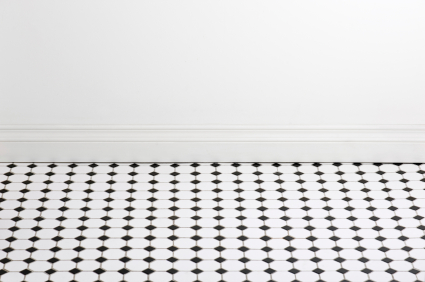 Bathroom floors carry water from showers, bathtubs and sinks. Sometimes wet dogs and children are running around after their baths. Believe or not, many bathrooms have carpet as the flooring material. With carpet and water, there is a risk of mold and mildew. Bathrooms also develop a lot of steam which can also convert to water that drips on the floors. If you have carpet in your bathroom, it may be time to use a more durable flooring like tile. You can always add areas rugs to prevent slippage or to keep your feet warm when getting out of the shower or tub. These areas rugs can easily be washed in your washing machine. If you have tile or linoleum and are ready for a change, here are the tips you need to get your new floor started. Replacing carpeting in bathrooms with ceramic tiles is a common project. It creates a hard and durable surface that also is much more suitable for water on the floors.
Bathroom floors carry water from showers, bathtubs and sinks. Sometimes wet dogs and children are running around after their baths. Believe or not, many bathrooms have carpet as the flooring material. With carpet and water, there is a risk of mold and mildew. Bathrooms also develop a lot of steam which can also convert to water that drips on the floors. If you have carpet in your bathroom, it may be time to use a more durable flooring like tile. You can always add areas rugs to prevent slippage or to keep your feet warm when getting out of the shower or tub. These areas rugs can easily be washed in your washing machine. If you have tile or linoleum and are ready for a change, here are the tips you need to get your new floor started. Replacing carpeting in bathrooms with ceramic tiles is a common project. It creates a hard and durable surface that also is much more suitable for water on the floors.
This type of project can vary in cost depending on how hard the removal of the existing material, if there is any damage to the sub-floor underneath the material. If there is damage, this will need to be repaired or replaced. The cost also depends on the size of your floor area and the type of material you are using. Some tiles costs more than others. Here is what you need to start thinking of to budget for this project.
Items for a new bathroom floor
Here is a basic list of materials for a new floor in a bathroom
| Base Boards | Paint |
| Flooring | Labor |
How to install ceramic tile in a bathroom
Remove the existing carpet and padding. You also need to shut the water off to the toilet and disconnect the toilet from the floor mounting. Then you should prep the sub-floor with the appropriate material based on the type of tile you selected.
After laying the tile, install the grout between all the tiles. Once you are done, you can reinstall the toilet and you now have a new look floor in the bathroom. For details on this project, view the video here.
This project can be completed by a professional if that is your preference.

